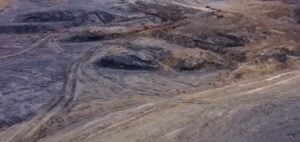It regenerates soils depleted by intensive agriculture, retains water and traps CO2 like a “carbon sink”: biochar, a charcoal produced from high quality plant residues, is arousing the interest of scientists and the growing appetite of industrialists.
For the past fifteen years, Roger Chabot, a winegrower in the Cognac region, has been burying these blackish granules at the foot of his trees. On his plots, the vines have become more vigorous, with “better chlorophyll levels and increased resistance to esca,” a fungus that causes wood disease, he explains.
Used in vineyards, forests and field crops, biochar (“bio” for plant, “char” for coal) has many agronomic virtues: with its porous structure and micro-cavities, it absorbs water and nutrients like a sponge. Its effectiveness varies according to the soil, but it can bring life back to the most damaged soils, by aerating them and developing microbial life, which improves fertility and makes it possible to apply less fertilizer.
But in addition to these agricultural benefits, biochar is a “negative emission technology” or “carbon sink”, as cited by the UN climate experts (IPCC): it can sequester carbon and store it for hundreds of years.
500 degrees
When plants decompose, they release the carbon stored during photosynthesis in the form of CO2. Except if it is transformed into biochar: the latter is trapped in the organic matter instead of being released into the atmosphere, explains Carine Coat, engineer at Sylva Fertilis.
This French company opened a dedicated plant in 2018 in Argentan, Normandy, with a capacity that will reach 800 tons this year. In its imposing pyrolysis furnace, four tons of forest and agricultural residues become one ton of biochar. This combustion at about 500 degrees and without oxygen carbonizes the biomass without burning it, and delivers coal in the form of small grains or flakes. “One ton of biochar can sequester 2.5 to 3 tons of CO2 equivalent,” explains Claire Chastrusse, founder of Carbonloop, another biochar start-up.
From the Minta forest in Cameroon to the Fontainebleau forest in France, projects and production sites are multiplying. But there is still a major obstacle to its development: its production cost. “It’s a wonderful solution in theory, but it’s been hard to deploy for the past 15 years,” says Axel Reinaud, one of the founders of the French start-up NetZero. Biochar “hasn’t quite found its economic model yet,” agrees Cyril Girardin, a doctoral student in soil science at the Inrae research institute.
Carbon credits
According to the industry, biochar sells for nearly 800 euros per ton in Europe. A heavy investment for farmers, who must use a few hundred kilos per hectare to benefit from its effects. To remedy this, NetZero is betting on large-scale production in tropical areas, such as Brazil, where it is inaugurating a factory on Thursday. On these lands, biomass is abundant, cheap, and little valued, and biochar is beneficial for barren soils degraded by deforestation. Moreover, its development could not have accelerated without the sale of carbon credits to companies that want to “offset” their emissions, a market that is growing exponentially but is criticized for its non-standardized methodologies.
By the end of 2022, the European Biochar Industry had identified 130 projects, mainly in Germany and the Nordic countries, with a capacity of 53,000 tons – still a drop in the bucket compared to the North American market. To lower costs, Carbonloop wants to link biochar production to energy production for industrial sites. Because the transformation of biomass by pyrolysis also allows to obtain biogas.
Renewable and carbon neutral, it can be transformed into electricity and heat, and heat the ovens of a glass factory, a factory… or self-power the pyrolyzer. “It may seem a bit idealistic, the circular aspect… but the strength of the model is that we can significantly improve agriculture, while massively decarbonizing it,” defends Axel Reinaud.





















